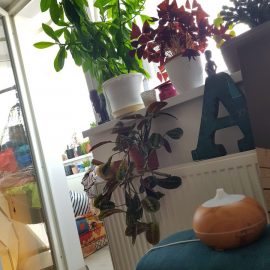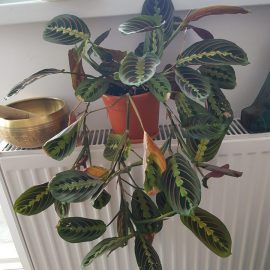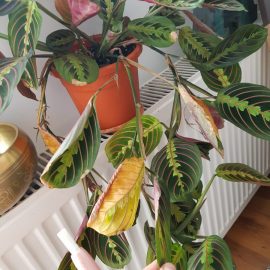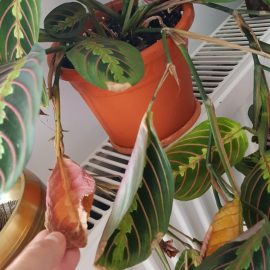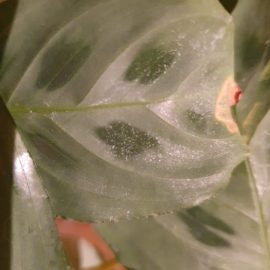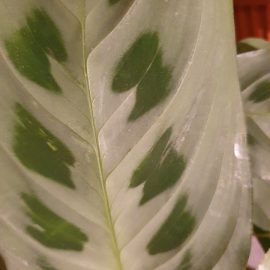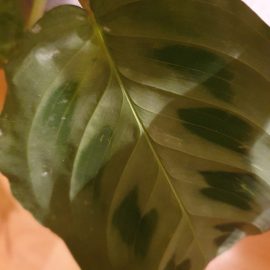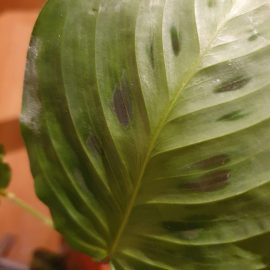Maranta, plant care and growing guide
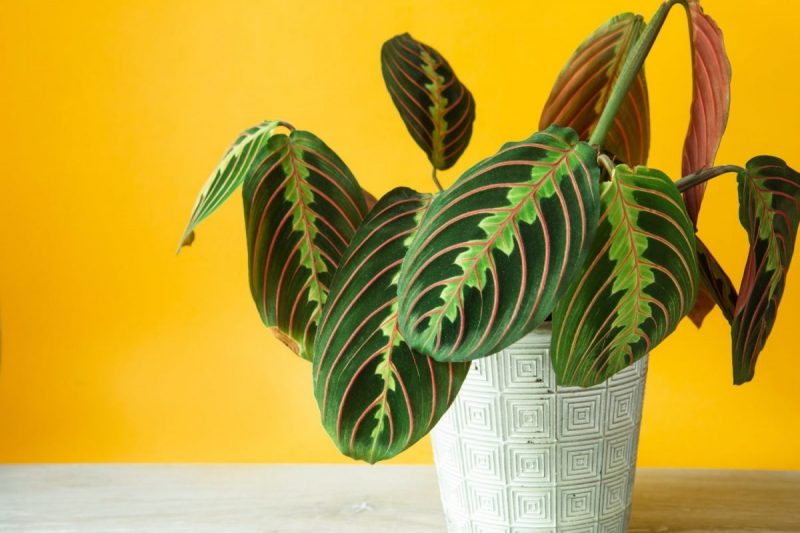
Maranta (Maranta spp.) is part of the genus Maranta, which includes approximately 30-40 species of plants, native to the tropical forests of Brazil. Maranta is used as an ornamental indoor plant, being appreciated for its decorative leaves. It is a rhizomatous, perennial, slow-growing plant that can reach a height of up to 30 cm.
The leaves are large, elliptical, velvety, predominantly green, with spots and ribs of different colors on the topside, depending on the species. The flowers are small, white, clustered in spikes, without ornamental value. In apartments it blooms extremely rarely.
Maranta – Species and varieties
- Maranta leuconeura: it is the most common species, standing out by the pattern and color of the leaves. The following varieties can be found within this species:
- M. leuconeura erythrophylla: with green, velvety leaves, on which yellow spots along the midrib and red arched ribs that extend to the edge of the leaf can be seen. The lower part of the leaf is purple;
- M. leuconeura kerchoveana: the leaves are green, on which brown spots can be seen, arranged on either side of the midrib;
- M. leuconeura massangeana: it has dark green leaves, with gray spots along the midrib, from which white ribs originate.
- Maranta cristata: the leaves are green, and along the rib it has a light green tint. The underside of the leaf has a purple hue.
- Maranta depressa: dark green or brown spots can be found on the leaves, on either side of the midrib.




Environmental conditions
Light. It can be placed near the window, but away from direct sunlight. Intense light can cause the discoloration of the leaves and can lead to the occurrence of sunburn.
Temperature. It prefers an average temperature of 18-23 °C. Temperatures that are too low can lead to the damage and fall of the leaves.
Humidity. Maranta needs a high atmospheric humidity, of at least 60%. Humidity can be kept high by regular spraying the plant with water at room temperature or by placing the pot on a tray with wet gravel.
Substrate. It is not picky in terms of substrate, but it is important that it ensures a good water drainage. You can use a regular substrate for houseplants.
Recommended products
-
You can find products on a different store
Change Store -
You can find products on a different store
Change Store -
You can find products on a different store
Change Store -
You can find products on a different store
Change Store -
You can find products on a different store
Change Store -
You can find products on a different store
Change Store -
You can find products on a different store
Change Store -
You can find products on a different store
Change Store -
You can find products on a different store
Change Store -
You can find products on a different store
Change Store -
You can find products on a different store
Change Store -
You can find products on a different store
Change Store -
You can find products on a different store
Change Store -
You can find products on a different store
Change Store -
You can find products on a different store
Change Store -
You can find products on a different store
Change Store -
You can find products on a different store
Change Store -
You can find products on a different store
Change Store -
You can find products on a different store
Change Store -
You can find products on a different store
Change Store -
You can find products on a different store
Change Store -
You can find products on a different store
Change Store -
You can find products on a different store
Change Store -
You can find products on a different store
Change Store
Maranta – Care
Watering. During the growing season, it needs regular watering (the substrate is not allowed to dry completely before watering again), using water at room temperature or slightly warm. The lack of water or an excessive humidity cause the yellowing and falling of the leaves.
During the cold season, the plant is watered less often.
Fertilizing. In order to preserve their decorative qualities, it is recommended to fertilize the plants regularly, during the growing season (from spring to autumn), with special fertilizers for decorative plants.
Recommended products
-
You can find products on a different store
Change Store -
You can find products on a different store
Change Store -
You can find products on a different store
Change Store -
You can find products on a different store
Change Store -
You can find products on a different store
Change Store -
You can find products on a different store
Change Store -
You can find products on a different store
Change Store -
You can find products on a different store
Change Store -
You can find products on a different store
Change Store -
You can find products on a different store
Change Store -
You can find products on a different store
Change Store -
You can find products on a different store
Change Store -
You can find products on a different store
Change Store -
You can find products on a different store
Change Store -
You can find products on a different store
Change Store -
You can find products on a different store
Change Store -
You can find products on a different store
Change Store -
You can find products on a different store
Change Store -
You can find products on a different store
Change Store -
You can find products on a different store
Change Store -
You can find products on a different store
Change Store -
You can find products on a different store
Change Store -
You can find products on a different store
Change Store -
You can find products on a different store
Change Store
Transplanting. Maranta can be transplanted once every 2-3 years, in the spring, when the flowerpot becomes too small, and the roots of the plant no longer have enough space to grow properly.
Propagation. Maranta can be propagated by dividing the bush, in the spring or when transplanting the plant. The new plants can be rooted separately, directly in the flowerpot.
Recommended products
-
You can find products on a different store
Change Store -
You can find products on a different store
Change Store -
You can find products on a different store
Change Store -
You can find products on a different store
Change Store -
You can find products on a different store
Change Store -
You can find products on a different store
Change Store -
You can find products on a different store
Change Store -
You can find products on a different store
Change Store -
You can find products on a different store
Change Store -
You can find products on a different store
Change Store -
You can find products on a different store
Change Store -
You can find products on a different store
Change Store -
You can find products on a different store
Change Store -
You can find products on a different store
Change Store -
You can find products on a different store
Change Store -
You can find products on a different store
Change Store -
You can find products on a different store
Change Store -
You can find products on a different store
Change Store -
You can find products on a different store
Change Store -
You can find products on a different store
Change Store -
You can find products on a different store
Change Store -
You can find products on a different store
Change Store -
You can find products on a different store
Change Store -
You can find products on a different store
Change Store
Diseases and pests
Maranta is prone to the occurrence of powdery mildew and rot. Among the pests, the most common are: mites, thrips, aphids and wooly apple aphids.
Additionally:
- Maranta is also popularly called the “prayer plant” because its leaves remain flat during the day, but at night they fold like praying hands. This phenomenon is called nyctinasty;
- Maranta is not toxic to humans and pets.














































































































































































































































































































































































































































